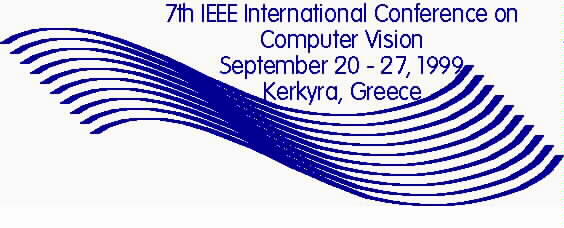 |
 |
The ICCV'99 Conference Plenary Session Presentations
Oral presentations at ICCV will take place during 10 time slots as shown in the conference timetable. The main ballroom will have multi-format video, 1024x780 resolution SVGA projector, overhead projector, 35mm slide projector - with two screens - and sound system available for your use. It will be entirely your responsibility to contact the technicians running the equipment for proper set-up for your presentation. To assist you with this, there will be two conference helpers (fluent in English and Greek) to guide you - they will be identified by AV badges/ribbons.
All presentations are of 30 minutes duration, 25 minutes to present and 5 minutes for questions. This constraint will be rigidly enforced.
In the list below each presentation will be prefixed with the session code (P1 for "Presentations 1" above, for example). If you are unable due to your travel constraints (only!) to accept your time slot, please let me know and we can try to make changes.
One of the poolside rooms (Room B) is reserved for speaker preparation. There will be an overhead projector, and a 1024x780 resolution SVGA Projector available in that room for your use.
Finally, please note that since the papers nominated for the David Marr Prize include at least one oral presentation, you may be moved to the prize session on the first day. The number of talks listed below do not fit into the allotted time on the assumption that 4 will be moved to the prize session. The final program will be known only a few days before the meeting; authors who will be moved to the prize session will be contacted separately. Your final time slot, if not in the prize session, will be determined by simply filling in the gaps left by the prize papers. The ordering below, except for the prize papers, will be maintained and is the same order in which the papers appear in the proceedings.
P1 Motion Based Decompositing of Video
Gabriel J. Brostow, Irfan A. Essa
P1 Stereo Reconstruction from Multiperspective Panoramas
Heung-Yeung Shum and Richard Szeliski
P1 Omnivergent Stereo
Heung-Yeung Shum, Adam Kalai, Steve Seitz
Real-time Active Vision and Computer Interfaces
P2 Exploiting Human Actions and Object Context for Recognition
Tasks
Darnell Moore, Irfan Essa, Monson Hayes III
P2 Real-time object detection for "smart" vehicles
Dariu Gavrila and Vasanth Philomin
P2 A dynamic Bayesian network approach to figure tracking with
learned dynamic models
Vladimir Pavlovic, James Rehg, Tat-Jen Cham, Kevin Murphy
P2 Backpack: Detection of People Carrying Objects Using Silhouettes
Ismail Haritaoglu, Ross Cutler, David Harwood, Larry Davis
Shape Representation and Recovery
P2 Camera Pose and Calibration from 4 or 5 known 3D Points
Bill Triggs
P3 Structure and Motion from Lines Under Affine Projections
Kalle Astrom, Anders Heyden, Fredrik Kahl, Magnus Oskarsson
P3 Combining Scene and Auto-calibration Constraints
David Liebowitz, Andrew Zisserman
P3 Invariant-based registration of surface patches
Joris Vanden Wyngaerd, Luc Van Gool, Reinhard Koch, and Marc Proesmans
P3 A Theory of Shape By Space Carving
Kiriakos N. Kutulakos and Steven M. Seitz
P3 On the Evolution of the Skeleton
Jonas August, Allen Tannenbaum, Steven W. Zucker
P4 Parallax geometry of smooth surfaces in multiple views
Geoff Cross, Andrew Fitzgibbon, Andrew Zisserman
P4 Trajectory Triangulation over Conic Sections
Amnon Shashua, Shai Avidan, Michael Werman
Motion Analysis
P4 Multi-View 3D Shape and Motion Recovery on the Spatio-Temporal
Curve Manifold
Rodrigo L. Carceroni and Kiriakos N. Kutulakos
P4 Fast Partial Search Solution to the 3D SFM Problem
Sridhar Srinivasan
P4 Fast Algorithms for Projective Multi--Frame Structure from
Motion
John Oliensis, Yakup Genc
P5 Correlation-based estimation of ego-motion and structure from
motion and stereo
Robert Mandelbaum, Garbis Salgian, Harpreet Sawhney
P5 Probabilistic Detection and Tracking of Motion Discontinuities
Michael J. Black, David J. Fleet
P5 Optimal Filters For Gradient-Based Motion Estimation
Michael Elad, Patrcik Teo, Yacov Hel-Or
P5 Direct Identification of Moving Objects and Background from
2D Motion Models
Gabriella Csurka, Patrick Bouthemy
P5 A probabilistic exclusion principle for tracking multiple
objects
John MacCormick, Andrew Blake
Physics Based Vision
P6 Polarization-based Decorrelation of Transparent Layers: The
Inclination Angle of an Invisible Surface
Yoav Y. Schechner, Joseph Shamir and Nahum Kiryati
P6 Vision in Bad Weather
Shree K. Nayar, Srinivasa Narasimhan
P6 The Hamilton-Jacobi Skeleton
Kaleem Siddiqi, Sylvain Bouix, Allen Tannenbaum, Steven Zucker
Segmentation, Grouping, and Feature Extraction
P6 Subpixel-Precise Extraction of Watersheds
Carsten Steger
P6 Segmentation of Salient Closed Contours from Real Images
Shyjan Mahamud, Karvel K. Thornber, Lance R. Williams
P7 A Statistical Approach to Snakes for Bimodal and Trimodal
Imagery
Anthony Yezzi, Jr., Andy Tsai, Alan Willsky
P7 Globally Optimal Regions and Boundaries
Ian H. Jermyn, Hiroshi Ishikawa
P7 Surface Topography from Intensity Images
Philip L. Worthington Edwin R. Hancock
P7 Textons, Contours and Regions: Cue Integration in Image Segmentation
Jitendra Malik, Serge Belongie, Jianbo Shi and Thomas Leung
P8 Geodesic Active Regions for Supervised Texture Segmentation
Paragios, Nikos and Deriche, Rachid
Texture
P8 Recognizing surfaces using three-dimensional textons
Thomas K. Leung, Jitendra Malik
P8 Texture-Based Image Retrieval Without Segmentation
Yossi Rubner, Carlo Tomasi
P8 Equivalence of Texture Ensembles and Fundamental Bounds --
Are we close to a grand unified theory for Texture Modeling and Analysis?
Ying Nian Wu and Song-Chun Zhu
P9 Texture Synthesis by Non-parametric Sampling
Alexei A. Efros and Thomas K. Leung
Matching, Recognition and Indexing
P9 Object Localization by Bayesian Correlation
J Sullivan, A Blake, M Isard, J MacCormick
P9 The Earth Mover's Distance under Transformations
Scott D. Cohen, Leonidas J. Guibas
P9 Dynamic Feature Ordering for Efficient Spatial Registration
Tat-Jen Cham, James M. Rehg
P9 Finding people by sampling
Sergey Ioffe, David Forsyth
Vision and Learning
P10 Error Detection and DEM Fusion Using Self-Consistency
Howard Schultz, Dong-Min Woo, Frank R. Stolle, Edward M. Riseman
P10 Learning low-level vision
William T. Freeman and Egon C. Pasztor
P10 Transformed Component Analysis: Joint Estimation of Spatial
Transformations and Image Components
Brendan J. Frey, Nebojsa Jojic
P10 Mean Shift Analysis and Applications
Dorin Comaniciu, Peter Meer